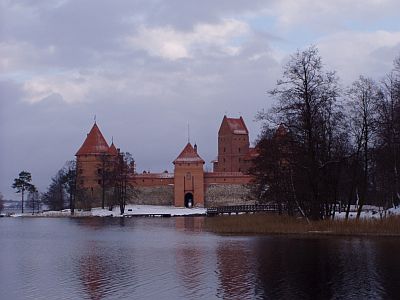History - a short overview
In contradiction to the other two Baltic States →Estonia and →Latvia, Lithuania has a long and glorious history of independence and wealth. Lithuanian predecessor settled in the area probably some 2000 years ago and stayed for around one thousand years without leaving many traces. Smaller principalities were founded around 1000. First attempts to christianize Lithuanians failed - most missionaries were immediately sent back to their Maker by pagan Lithuanians. In 1236, Lithuanian tribes united to get rid of the German Livonian Brothers of the Sword. In 1253, Grand Duke Mindaugas united the principalities by the force and declared himself king - but not without getting baptized beforehand. He hadn't had much pleasure with the new title - ten years later he was murdered. And Lithuanians turned back to paganism. They were only finally christianized in 1387, which is unusually late for a European nation.
In the 14th century, Grand Duke Gediminas played a great role as well. Many principalities of the weakened Kievan Rus joined Lithuania by themselves or were simply conquered. As a result of a clever matrimonial policy, a strong union with Poland was eventually established in 1385. Thanks to this union, Lithuania could defeat the Prussian and Livonian knights of the Teutonic Brothers of the Sword at the famous Battle of Grunwald (near present-day Žalgiris) in 1410. After that, Lithuania reached its largest extension - the entire present-day →Belarus, large parts of the →Ukraine as far as to the city of →Odessa and some other areas belonged to the Lithuanian nation.

| ||
| Lithuania has plenty of historical monuments |
Only the very southwest corner (at the sea) of present-day Lithuania was about to remain a part of Prussia until 1918. However, Poland gradually became stronger and started to dominate the union within the next centuries. Despite that, the Lithuanian language and culture was booming, but less and less political decisions were made by Lithuanians but mostly by Polish. Still, the union persisted until 1795, the year of the Third Partition of Poland (see →History of Poland). Lithuania then became a part of Russia, which had a very negative influence on the further development of Lithuania and its culture. Several uprisings during the 19th century weren't really successful - instead, the "russification" became increasingly stronger.
Germany invaded Lithuania already during World War I - in 1915, to be exactly. In 1918, when the war was over, Lithuania proclaimed the independent Republic of Lithuania. Germany retreated, but then →Poland and the young Soviet Union started to assort their claims over Lithuania. The young republic could not do much against Poland occupying →Vilnius and the wider area around it. The capital therefore was moved to Kaunas. Next, Lithuania itself occupied the until then German territory of Memelland in the west. However, Lithuania gradually developed into a dictatorship.
Things became turbulent in 1939. The pressure from Germany was too big, and so Lithuania had to hand back the Memelland around the town of Klaipėda (Memel). As with the two other Baltic States, Lithuania eventually fell victim to the Secret Protocol of the Molotov-Ribbentrop Pact (aka Treaty of Nonaggression between Germany and the Union of Soviet Socialist Republics). As a result, the Soviet Union first placed troops in the country and finally invaded it completely the year after. Ten thousands of Lithuanians lost their lives afterwards during Stalin's infamous purge. In 1941, the German Wehrmacht invaded the country. Until then, Lithuania was famous for its thriving Jewish culture, but the Germans deported an estimated 200,000 Jews after the invasion - almost all of them should never return.
In 1944, the Red Army took over again, followed by years of russification, forced collectivization and deportations. Almost the entire republic became a no-go area for foreigners and most other Soviet Union citizens. Things only changed for the better with the perestroika at the end of the 1980's. 1990, Lithuania declared its independence - as the first Soviet Republic to do so. The independence was finally acknowledged by Moscow in 1991, but unfortunately it wasn't completely peaceful. In January 1991, on the so-called Bloody Sunday (yes, that's not limited to Ireland...) and in July 1991, 21 Lithuanians were killed during some skirmishes along the border.
After declaring independence, the country started to develop quickly. Lithuania became democratic and the economy recovered gradually. On 1 May 2004, Lithuania joined the EU and earlier before already the NATO. But this caused some serious issues, since the Kaliningrad Oblast' (aka Königsberg) west of the country is a Russian exclave without direct connection to Russia. So far, Lithuania wasn't very keen to simplify the strict visa and customs procedures for Russians trying to get from Kaliningrad to Russia and vice versa. Travelers will experience the same.
©2024 Europe-East.com

 Albania
Albania Lithuania
Lithuania